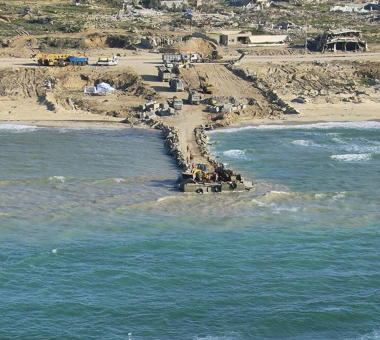U.S. Pier in Gaza and the Chances of Successful Delivery of Aid By Sea
A situation assessment on the temporary pier in the Gaza Strip, which the U.S. military is building to enable the Gaza Strip to receive large shipments of aid, and the challenges facing plans to deliver aid by sea.
by STRATEGIECS Team
- Release Date – Mar 24, 2024

With the UN warning that famine is “imminent,” Israeli blocking aid from arriving by land, and the relative limited aid airdropped into the area, the United States is building a temporary pier that will allow vital humanitarian supplies to help starving and injured Palestinians trying to survive in the Gaza Strip.
The project, however, raises several questions and challenges, the most important of which is the actual need for a pier, its future use, and how it can be used to serve U.S. policies towards the Palestinian cause in the post-war phase.
The first announcement of the pier came on March 8, 2024, when President Joe Biden, during his State of the Union address to Congress, talked about the U.S. military’s intention to establish a floating pier anchoring floating health and housing facilities. Less than 36 hours later, the logistical support ship “General Frank S. Beeson” sailed from Virginia to the eastern Mediterranean, carrying the necessary equipment to build the pier. The Pentagon stated that constructing the pier may take about 60 days and requires the presence of 1,000 U.S. soldiers off the coast of the Gaza Strip.
The U.S. plan aims to enable the Gaza Strip to receive large shipments of aid, including 2 million daily meals to alleviate growing starvation. The pier is an alternative to the land routes, as Israel disrupts and prevents the entry of most aid trucks through the Rafah and Kerem Shalom crossings.
Meanwhile, even the small amount of aid allowed to enter by land is mostly distributed in the southern areas of the Gaza Strip and does not reach the northern side of it, which was cut off from aid months ago after it became a major focus of the Israeli offensive. This prompted the need to bypass the Israeli blockades and resort to airdrops for aid delivery. On November 6, 2023, Jordan became the first country to airdrop vital humanitarian aid when a Royal Air Force aircraft delivered medical supplies and food to the Jordanian field hospital in the Gaza Strip.

However, large-scale airdrops have proven ineffective and insufficient to stave off the imminent risk of famine and meet the needs of the population of the Gaza Strip, especially in the north. In addition, airdrops are a costly method due to the associated use of aircraft, fuel, and personnel. The World Food Program estimates the cost is seven times higher than ground delivery. It is also associated with several risks and caveats, especially after it was criticized for the repeated falls of aid into the sea or in Israel. In addition, these landings led to deaths among Palestinians as a result of parachutes malfunctioning.
Motives for the U.S. Move
The U.S. administration’s decision to build the pier comes at a very sensitive time politically. Democratic President Joe Biden and Republican candidate former President Donald Trump are competing in an election race that is difficult to predict and in a way that requires Biden’s actions to be very deliberate, including avoiding exacerbating the growing criticism of his administration’s support of Israel in the war in the Gaza Strip. This criticism has begun to expand within the Democratic Party itself and also among those normally most supportive of the president and Israel, including Senate Majority Leader Chuck Schumer, a Democrat.
Thus, establishing the temporary pier and the massive entry of aid into the Gaza Strip may rebalance popular and political attitudes towards the U.S. administration ahead of the elections, and it could even be presented by the U.S. president as a celebratory achievement since Palestinians in the Gaza Strip are on the brink of famine and Israel severed most aid delivery routes . At the same time, this move eases the international criticism of U.S. military and economic positions in support of Israel. This move also keeps the United States at the forefront of international initiatives and efforts to deliver humanitarian aid to the Gaza Strip.

On the other hand, this American step sends a message to the Israeli government that Washington will neither allow the situation to spiral out of control as a result of the war nor will it tolerate the collapse of the humanitarian situation in the Gaza Strip, especially at a time when it appears that cooperation between the U.S. administration and the government of Israeli Prime Minister Benjamin Netanyahu is facing several challenges. A set of differences between the two have developed since the outbreak of the war on October 7, 2023, reaching a critical stage in the history of the relationship between the two countries. This includes the Israeli intention to storm the city of Rafah, which United States opposes, and American pressure on Israel to reach a humanitarian truce within the month of Ramadan, which puts several difficulties before Netanyahu, the most important of which is not granting the Israeli negotiating team broad powers, making negotiations an administrative issue that requires more time and imposing the need to overcome complex internal disagreements.
In return, Israel saw in the U.S. move an opportunity to reduce disputes, which is why it was welcomed by Israeli officials, because it would also support the IDF’s plans to complete the war and possibly storm the city of Rafah while weakening Hamas’s administrative and civilian control over the Gaza Strip.
In general, Israel views the sea lanes—whether the American port or the corridor that the European Commission and European and regional countries announced their intention to open—as steps that will weaken Hamas and strengthen Israeli control. As stated by Israeli Defense Minister Yoav Galant, that the sea passage will weaken Hamas, strengthen the control of the Israeli army, and improve Israel’s capabilities to continue fighting.
The distribution of aid by sea may augment the Israeli plan for local Palestinian leaders to distribute and store aid at the expense of the previous roles of United Nations Relief and Works Agency and the Hamas government. Besides, the aid that will enter through the port will remain under Israeli security control, as Israel will check the aid cargo in Cyprus before it heads to the Gaza Strip.
Challenges of Delivering Aid by Sea
The plans to deliver aid by sea, especially the U.S. plan to establish a port or the European Commission’s plan for the sea corridor on the coast of the Gaza Strip, face many challenges and repercussions that may affect the desired results.
1- The arrival of naval aid intensively and efficiently requires a long period of time compared to the acceleration of events and the scale of the humanitarian catastrophe in the Gaza Strip. It also faces great logistical complications that will make this corridor slow. Thus, it will not be an ideal substitute for Israel’s opening of land crossings for the entry of aid.
2- It is not clear who is able to distribute aid nor the mechanisms for distributing it to Palestinian citizens in the Gaza Strip, specifically in its northern region.
3- These projects do not dismiss Israeli control over aid, especially in the case of the sea corridor, where Israel supervises aid from the moment it is loaded until it is distributed.
4- There are concerns that waterways may be later exploited by Israel to facilitate voluntary exodus of Palestinian citizens from the Gaza Strip.
5- Providing aid, away from the Rafah crossing, could facilitate Israel’s military operations in the city of Rafah, especially as the crossing allows the evacuation of civilians from Rafah to central and northern Gaza Strip.
Finally, waterways, including the U.S. pier, cannot be isolated from the developments of the war in the Gaza Strip, the developments in the American political scene after the presidential elections scheduled for November 2024, or the changes that the Israeli arena may witness, especially at the level of the government coalition and the war council, which may witness several possible scenarios.

STRATEGIECS Team
Policy Analysis Team
 العربية
العربية